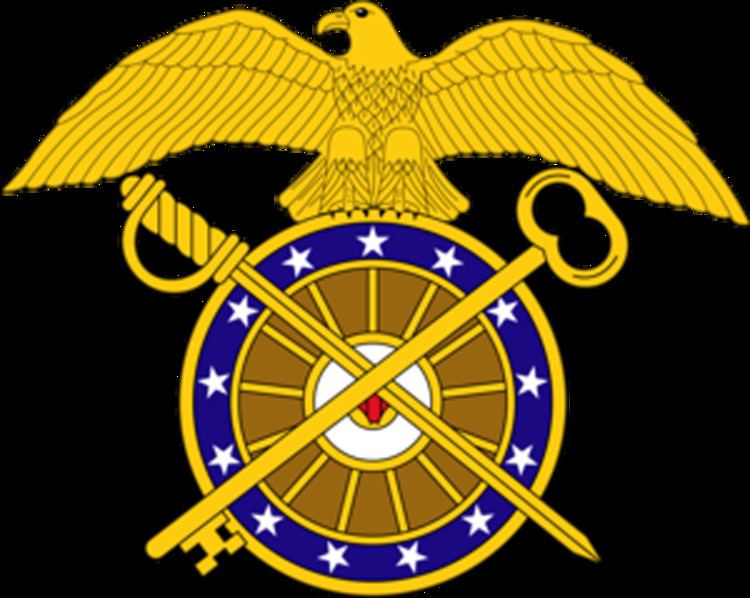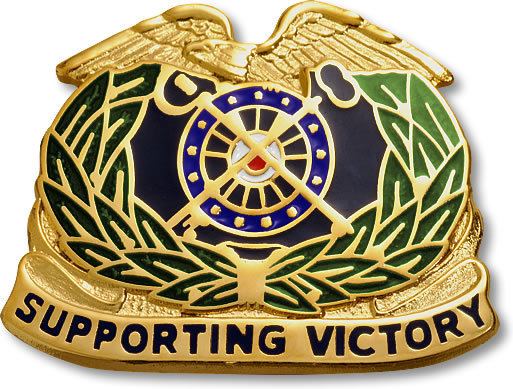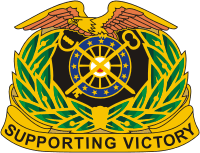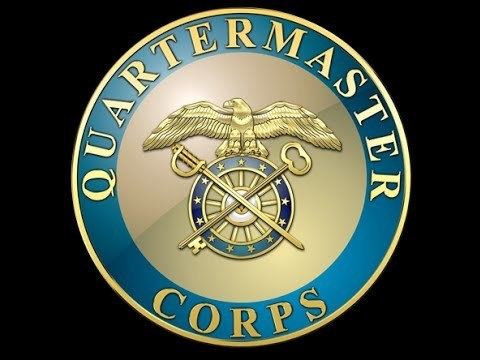 | ||
Similar Military Police Corps, Military Intelligence Corps, Medical Corps, United States Army Res, United States Army Civi | ||
The United States Army Quartermaster Corps is a Sustainment, formerly combat service support (CSS), branch of the United States Army. It is also one of three U.S. Army logistics branches, the others being the Transportation Corps and the Ordnance Corps.
Contents
- History
- Insignia
- Functions
- Former functions
- Units
- Military Occupational Specialities
- Leadership School
- In the media
- Military Order of Saint Martin
- References

The U.S. Army Quartermaster Corps mission is to support the development, production, acquisition, and sustainment of general supply, Mortuary Affairs, subsistences, petroleum and water, material and distribution management during peace and war to provide combat power to the U.S. Army. The officer in charge of the branch for doctrine, training, and professional development purposes is the Quartermaster General. The current Quartermaster General is Brigadier General Rodney D. Fogg.

History

The Quartermaster Corps is the U.S. Army's oldest logistics branch, established 16 June 1775. On that date, the Second Continental Congress passed a resolution providing for "one Quartermaster General of the grand army and a deputy, under him, for the separate army". From 1775 to 1912, this organization was known as the Quartermaster Department. In 1912, Congress consolidated the former Subsistence, Pay, and Quartermaster Departments to create the Quartermaster Corps. Quartermaster units and soldiers have served in every U.S. military operation from the Revolutionary War to current operations in Iraq (Operation Iraqi Freedom) and Afghanistan (Operation Enduring Freedom).
Insignia
Functions
The function of the Quartermaster Corps is to provide the following support to the Army:
Former functions
Former functions and missions of the Quartermaster Corps were:
Units
Quartermaster detachments, companies and battalions are normally assigned to corps or higher level commands. Divisions and smaller units have multifunctional support battalions which combine functional areas from the Army Transportation Corps, Army Quartermaster Corps, Army Ordnance Corps, and the Army Medical Service Department.
Quartermaster organizations include field service, general supply, petroleum supply and petroleum pipeline, aerial delivery (rigger), water, and mortuary affairs units. Most are company level except petroleum and water, which has battalion and group level units. There is one Bulk petroleum Company on Active Duty.
Military Occupational Specialities
The nine Quartermaster Enlisted Military Occupational Specialties (MOSs) are:
The five Quartermaster Warrant Officer Military Occupational Specialties (MOSs) are:
The three Quartermaster Officer Areas of Concentration (AOCs) have been merged into 92A as Additional Skill Identifiers (ASIs)
Leadership / School
The officer in charge of the branch for doctrine, training, and professional development purposes is the Quartermaster General. The current Quartermaster General is Brigadier General Rodney D. Fogg. The Quartermaster General does not have command authority over Quartermaster units, but instead commands the United States Army Quartermaster Center and School, located at Fort Lee, Virginia, near Petersburg. This school provides enlisted advanced individual training (AIT) and leader training for Quartermaster officers, warrant officers and non-commissioned officers.
For a list of US Army Quartermaster Generals, see Quartermaster General (United States).
In the media
The Quartermaster Corps provides a host of vital services to the U.S. Army. But, because these jobs are often not glamorous, very little is mentioned about Quartermaster soldiers in the mainstream media. The Global War on Terrorism and the 11 September attack on the Pentagon, as well as operations in Iraq and Afghanistan, have brought several Quartermasters briefly into the spotlight. Here are a few who have recently gained attention:
Military Order of Saint Martin
The Quartermaster Corps established this military decoration on 7 February 1997. The emblematic figure is of Saint Martin of Tours. The medal, for Quartermasters either on Active Duty, in the Reserves, or Civilian status, is awarded in three grades:
An updated list of recipients is maintained on the Association of Quartermasters website.
